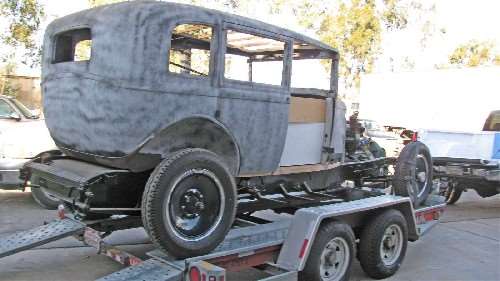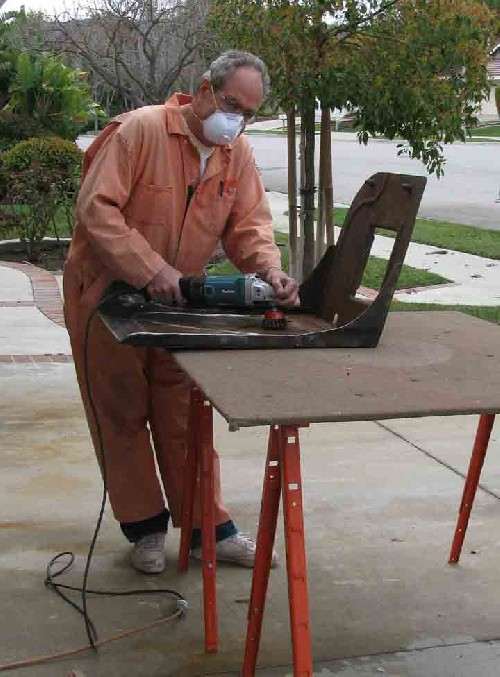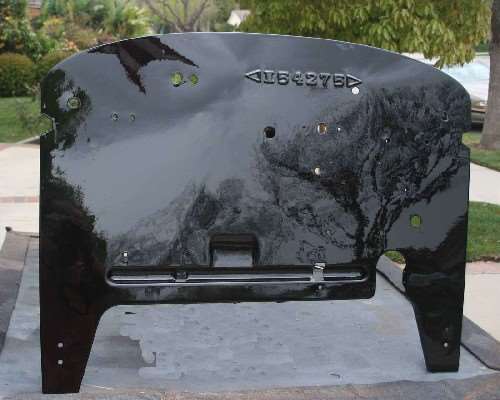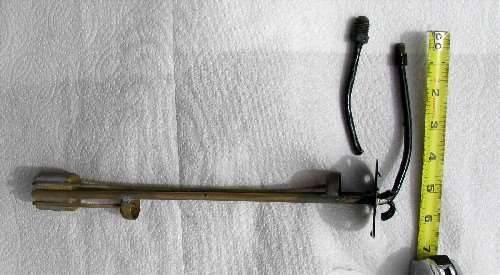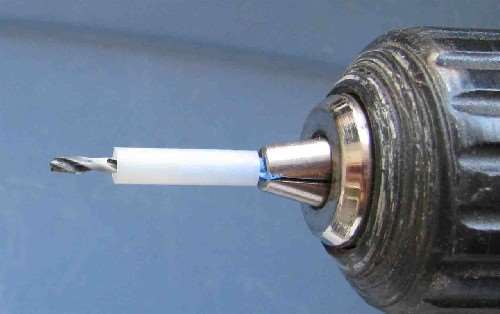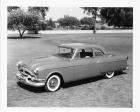|
Re: Our 1932 901
|
||||
|---|---|---|---|---|
|
Forum Ambassador
|
Marston,
Looking forward to following along as your '32 901 restoration progresses.
Posted on: 2011/2/6 23:34
|
|||
|
Mal
/o[]o\ ====  Bowral, Southern Highlands of NSW, Australia "Out of chaos comes order" - Nietzsche. 1938 Eight Touring Sedan - SOLD 1941 One-Twenty Club Coupe - SOLD 1948 Super Eight Limo, chassis RHD - SOLD 1950 Eight Touring Sedan - SOLD What's this?  Put your Packard in the Packard Vehicle Registry! Here's how! Any questions - PM or email me at ozstatman@gmail.com |
||||
|
||||
|
Re: Our 1932 901
|
||||
|---|---|---|---|---|
|
Home away from home
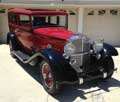
|
I hope to keep the blog reasonably up to date and I'm shooting for weekly (unless of course I'm out of town).
Right now, my main push is to get the body ready for final paint. I just picked up most of the stuff I need for priming (will be using an epoxy primer). There are two areas on both sides where I need to replace some metal (~ 1 sq. ft) just in front of the front doors. In between body work, I want to figure out how the brakes and clutch pedals connect to their operating parts. The previous owner has all of the cables for the brakes almost installed but there are several tie rods that still need to be connected.
Posted on: 2011/2/8 2:35
|
|||
|
||||
|
Re: Our 1932 901
|
||||
|---|---|---|---|---|
|
Home away from home

|
Didn't get much done on the car the week before. The wife and I decided to get in the RV and go out with some friends on a local trip.
This past week was focused on working on the insulation board between the two firewalls. The one that came with car was a pile of pulp. I still have not decided if I'll make one or buy one from Quite Ride. The car had the anti-thief wall sitting in place (no bolts) without a board. Since the engine was already installed in the car, it was impossible to just remove the firewall. So I unbolted the body from the frame, leaving it attached to the wood sills. Jacked it up and placed it on pipe rollers and then push it back several inches. Not a big thing, just a pain in the rear. The inside area of the anti-thief wall was lightly coated with rust while the outer part was primed with only several small areas showing signs of rust. Got out the trusty grinder and installed a stiff rotary wire brush to knock off the rust and get down to good metal on the inside and to scuff up the outer primed side. On the outer side the brush was used to get to metal where there were rusty areas. The inside area of the inner firewall had been primed many years back by the previous owner, but there were some areas which were showing signs of rust beginning to develop. These were attacked with the wire brush. That is where the firewall project remains for now as we are looking at 5 days of rain in sunny Southern California. When it stops, I'll roll the car out of the garage and shoot the inside sections of both firewalls and the outside section of the anti-thief wall gray "Rust Bullet". The outside part of the anti-thief wall will then be sprayed with gloss black enamel. In addition, I attacked the steel on the driver's seat frame with an extremely stiff rotary wire brush in the grinder since it had a worse case of rust than the firewalls. Was unable to finish the seat before the storm hit, but will wrap it up as soon as the sun makes its way back into our lives. If there are any real stubborn areas of rust or areas where the brush can't get into, I'll use some Krud Kutter (a phosphoric acid rust remover) to finish it off. The frame will then be sprayed with black Rust Bullet.
Posted on: 2011/2/19 22:51
|
|||
|
||||
|
Re: Our 1932 901
|
||||
|---|---|---|---|---|
|
Home away from home

|
Since the last report I decided that I would make the insulation board that goes between the inner and outer metal firewalls instead of buying one from "Quite Ride" or Max Merritt. This decision was based on answers that I posted on another site and the input from several users there as to what they had done.
I went with ?" MDF, which was about 1/8" thicker than the metal bushings that were in the remnants of the old one. I used an electric plane to get the thickness down to 5/8". I then cut a piece of thin cardboard that fit the outer firewall to use as a pattern for the various holes. Forstner bits were use to drill all the holes except the large ~3" holes where there were hardwood bushings where the hood braces connect the firewall and radiator. The 3" holes were cut using a fly cutter in an electric drill. A router was used to cut reliefs in the MDF board where there were places where the steel protruded and to cut the grove for the vacuum line. Final fitting afterwards took about four to five hours of trial and error (seemed like most error with a lot of trial). Once everything fit the board was given 2 coats with an oil based wood primer. On the outer side of the board I decided to laminate it with aluminum foil to reflect heat back into the engine compartment. I ended up using the "heavy duty" foil that you can find in super market and 3M spray adhesive. To finish off the project, rust was removed where necessary from both firewalls and then the metal prepared and primed with a 2K primer. Low spots on the outside section of the outer wall were filled with a lightweight body filler. Two more coats of 2K primer were sprayed on and allowed to cure for several days. It was then sanded ending up with 400 grit paper in order to obtain a smooth finish before spraying with 3 coats of black acrylic enamel. The last coat being a wet one with extra reducer to yield a non-orange peel finish. Overall everything turned out nice looking, but was more involved that I thought it would be. The trial and error portion was more time consuming than what I thought it would be. Guessing more time should have been spent on making the cardboard template rather than yielding to that "lets get started on this thing" urge. Oh well I saved at least $170 and enjoyed the project.
Posted on: 2011/3/21 17:54
|
|||
|
||||
|
Re: Our 1932 901
|
||||
|---|---|---|---|---|
|
Just popping in

|
Marston, I'm working on a 901 and have been for several years...not the fastest around for sure. If I can help you, please let me know...B
Posted on: 2011/3/21 18:16
|
|||
|
||||
|
Re: Our 1932 901
|
||||
|---|---|---|---|---|
|
Home away from home

|
GREAT - Thanks for the offer. I'm sure that I'll have plenty of questions. Most of he small stuff is in boxes and since I didn't take it a part I know that it'll be a challenging experience.
Posted on: 2011/3/21 18:23
|
|||
|
||||
|
Re: Our 1932 901
|
||||
|---|---|---|---|---|
|
Home away from home

|
For the last month or so, the tasks at hand have been working on getting the body ready for paint. The primer that was sprayed on by the previous owner (PO) is being block sanded with 80 then 150 grit paper before spraying several coats of 2K primer. So far, there have been no real bad spots - just a few low areas that show up as the 2K is blocked sanded with 150 and 320 grit paper. These are being filled with Evercoat Rage body filler and two additional coats of 2K primer will be sprayed on. This will be allowed to cure before final painting.
All nails along the roof were removed so the 1" chicken wire that was sticking out could be removed. For now, the roof has been temporarily screwed down using short #6 screws every 8" or so to the make sure that the roof was in the correct position for sanding and priming. Along with the sanding, time was spent working on doors and the door post. The loose wood screw holes were plugged using stepped dowels available from Woodcraft (suggestion by Jim Wayman worked out great). The metal on the back posts for both rear doors was removed and the wiring replaced. The previous owner had already bought various wiring harness for the car, but I didn't find one with wires for this area. Therefore, I used regular 12 gauge wire figuring that it would be out of sight. New body sills and bows for the roof, which had been made by the PO, along with all the wood was primed with an oil based primer (Sherwin-Williams colored the darkest gray they could mix). This was painted with a black oil based paint (S-W). Right now the wood under the rear window needs to be replaced and I'll put that on my to do list for now. I'll do all the remaining wood stuff like the wood for the seats, the piece that goes over the front window and flooring all at the same time.
Posted on: 2011/5/26 13:19
|
|||
|
||||
|
Re: Our 1932 901
|
||||
|---|---|---|---|---|
|
Home away from home

|
As a diversion to all the sanding, I decided to repair the king-Seely Sending unit. The fuel line was broken off where it exits the tank flange. Upon examining the unit it was determined that the unit had been repaired in the past where both the fuel and air lines exit the flange. Soft solder appeared to have been used to solder the areas where the tubing was broken.
Four one foot long lengths of 0.25" o.d. brass tubing and one of 9/32" o.d. with 0.014" wall were purchased from an e-store. Two ?" sections of the 9/32" tube was cut to be used as bushings. The first attempt to bend the ?" tube failed because the stiff brass collapsed. Therefore, one end of the tube was crimped shut and the tube filled with salt. Then the other end was crimped shut and the next attempt to bend the tube 90 degrees was successful. The 1/4" tube was cut to size and the flare fitting was removed from the broke piece of tubing. At that point, the fuel line was cut about 1/3" above the surge cup with a fine tooth hacksaw blade and the broken piece removed by heating the flange to melt the soft solder. The areas to be soldered were cleaned with extra fine emery cloth, solder paste applied, the 9/32" union slipped in place and the ?" inserted through the flange and into the open end of the union. The position of the air line was use to , align the fuel line. Lead based solder was used for the soldering of all the joints and to fix the tube to the flange. The air was replaced using the same process above. After soldering, everything was cleaned up using hot soapy water, dried and the steel flange painted with a black, fuel proof epoxy paint.
Posted on: 2011/6/21 20:02
|
|||
|
||||
|
Re: Our 1932 901
|
||||
|---|---|---|---|---|
|
Home away from home

|
The rain gutters (which are aluminum) and the sheet metal at the top of each door had been removed by the previous owner along with the sheet metal at the top of each door. During the removal process they were slightly bent and needed straightening before being re-installed.
The sheet metal was worked with a hammer and dolly to get it as flat as possible. It was then sanded to bare metal and given 3 coats of a 2K primer. After drying for a 3 days, they were block sanded and high spots were removed with the hammer on an anvil and dolly. Low spots were filled with a Evercoat Rage. The next day they were again block sanded and sprayed with 3 coats of 2K primer. At this point they looked good and flat. However, one did require more work as described above. The rain gutters were more of a challenge. The nails from the original installation were cut off as close as possible to the gutter itself. Any remaining part of the nail was removed using a 1/8" sanding disk on a rotary grinder. The back side of the gutter was reformed to give it some of the curvature that it originally had. This was done using a curved body hammer with light tapping. The next step on the gutters was to straighten them along both longitudinal axes. New holes for nailing were drilled between the old holes. The holes on the outside of the gutter were drilled slightly larger so the nail head would be countersunk to allowing for filling with Evercoat Rage. Multiple samples of available body nails were obtained and none seemed to be correct for nailing the gutter in place. However, #15 panel nails at the local hardware store seemed to be close diameter, but proved to be too long (1 5/8") to drive into the hardwood frame and the head was larger in diameter than what I wanted. Therefore, I decided to shorten them to 1 ?" by cutting with lineman's pliers and filing a new point. Also, the diameter of the nail head was reduced by placing the nail in a drill and reducing the size with a file while the drill was turning. Nice product, but a little time consuming when one needs about 120. Packard had installed the gutters using two #4 machine screws at the front and one #4 screw at the rear of the gutter. Using a screw at the rear was no problem since it only involved using the existing hole. However, the two at the front were rusted in and twisted off. I attempted to drill new holes, but the metal under the body's sheet metal must be a harden steel and proved to be beyond drilling. The sheet metal was reinstalled at the top of each door making sure that was it straight and flat going from front to rear and was square to the doors side to side. Care was taken to see the metal on the front and back doors met correctly at the center door jam. Number 16 panel nails were used for this installation. Now came the time consuming part of dry fitting the gutters in place. The gutters were bent so they would conform to the curvature of the body. Then the rear of the gutter was temporarily installed using a flathead #4, stainless steel machine screw (note the hole on the gutter was countersunk so the screw could be filled over) and the front end using a #16 panel nail (smaller than the #15's described above). Since the front of the gutter could not be attached any closer than 1 ?" from the front end, this area was bent inward so that nail would pull it tight against the body. Both ends were fitted so they met the reveals (front and rear) on the body, which required some filing. Starting at the front the gutter, it was bent, twisted as required so it fit such that it was slightly lower than the sheet metal of the door jam. Every 8 to 12 inches a clamp (see photo) was used to hold it in place so a 5/64' hole could be drilled through the body's sheet metal and the gutter "tacked" in place with a #16 nail driven halfway in. A short piece of nylon tubing was used on the drill bit as a stop during the drilling process so the hole would only be 3/8" deep (see photo). The process of positioning, clamping and drilling was repeated every 8 to 12" or so depending on how straight the gutter was. The gutter was also twisted as necessary while going down its length. Once I got about two-thirds of the way down the gutter (front to back) the rear #4 screw was removed. Then once I was past the rear door the curvature of the gutter was increased or decreased as required in order to align the hole in the gutter with that in the body for the rear machine screw. Then final minor adjustments were made to the gutter's alignment and its fit was adjusted down its entire length. All of the holes in the body were then drilled. Blue painters tape was used to mask off the area next to gutter to make cleanup from any squeeze out of the 3M Seam Sealer (P/N 08505) that was going to be used to ensure a water tight joint between the gutter and the body. Then the gutter was removed and the primer on the gutter and body was degreased. Starting at the front, a bead of sealer was placed on the body about one third of the distance. Nailing began starting with the first hole working back towards the rear. Five or six nails would be driven into place and the alignment was checked before they were driven all the way in and tightly count sunk. The process was repeated and when I got close to where the sealer ended, several more feet of sealer was laid down and more nails driven. Afterwards, the blue tape was removed and excess sealer removed and cleaned up using acetone. The holes in the gutter were then filled with Evercoat Rage. The gutter was then block sanded using a small custom made wood block that conformed to the gutter's curvature to remove the excess filler. Several high spots in the gutter were also filed to ensure that the surface was flat. The gutter was then primed again with a 2K material.
Posted on: 2011/8/13 10:41
|
|||
|
||||

 (91.31 KB)
(91.31 KB)